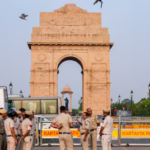
For the first time in decades, an Indian grey wolf was reportedly seen in Delhi, near the Yamuna floodplains in Palla. The sighting, made by wildlife enthusiast Hemant Garg last Thursday morning, has left experts both excited and cautious.
The Indian grey wolf, native to India’s grasslands and scrub forests, hasn’t been officially recorded in the capital since the 1940s. But around 7:45 am, Garg spotted what he believes was a lone wolf walking by the river, its dusky grey coat standing out in the morning light. “It didn’t move like a stray dog—it had grace and power,” he said.

While some experts confirm it’s likely an Indian grey wolf, others are urging restraint. There’s a chance it could be a wolf-dog hybrid. “The tail curve and fur color raise questions.
Here are some Pictures, have a look
Tucked away in the untamed beauty of Jharkhand, Mahuadanr Wolf Sanctuary is India’s only haven for the mysterious Indian Grey Wolf. 🐺#OutlookTraveller #HiddenIndia #WildlifeConservation #TravelMore #ExploreJharkhand https://t.co/bPOdPQ2vHg pic.twitter.com/lmZFiucCjx
— Outlook Traveller (@oltraveller) April 30, 2025
Only a genetic test can confirm,” said a senior wildlife researcher. Still, the animal’s broad chest, sharp jawline, and coat pattern closely match that of the Indian grey wolf.
This unusual sighting has reopened conversations about Delhi’s urban wildlife corridors. “It could’ve followed the river up from Rajasthan or UP. Nature doesn’t recognize state borders,” said Abhishek Gulshan, founder of NINOX – Owl About Nature.
For Delhi’s concrete jungle to host such a rare species is nothing short of remarkable. It’s a sharp reminder that wildlife can survive—even thrive—in surprising places. But it also shows how fragile these green corridors are. If a wolf made it this far, what else might be out there?
Delhi’s Forest Department, however, remains unconvinced. “We have no official wolf records in recent years,” a senior official said.
The Indian grey wolf is an apex predator in its ecosystem but often lives dangerously close to human activity. Its presence—confirmed or not—should push us to rethink how we treat the remaining wild patches in our cities.
One thing’s clear: nature doesn’t give up that easily. Even in the smog and sprawl of Delhi, life finds a way.
Also Read Dire Wolves Are Back After 13,000 Years: Meet Romulus, Remus, and Khaleesi












